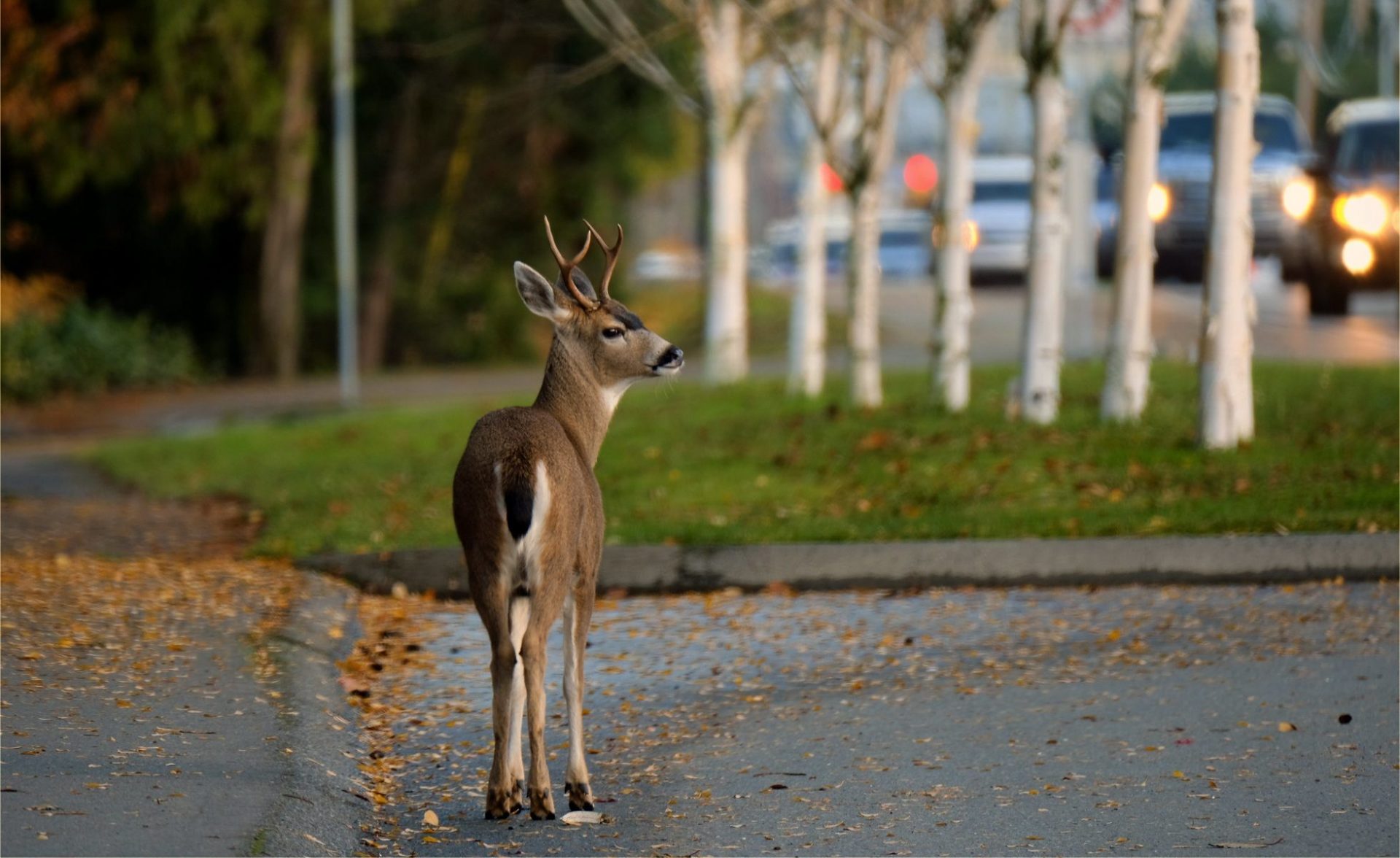
Rethinking roads can drive down species decline
From insects to birds, reptiles and amphibians, to opossums to bears, raccoons, cougars, coyotes and foxes, thousands of creatures are killed by cars every day. (Photo: marneejill via Flickr)
With roads closed and vehicle traffic down during the pandemic, some animals are getting a better shot at survival. Roads are a main driver of wildlife decline in Canada, taking their toll in myriad ways.
First, vehicles hit wildlife trying to cross roads. This has imperilled several reptile species in Canada, including the endangered Blanding’s turtle. Turtles generally reproduce late in life, so even a small number killed can lead to population declines. Because females usually wander in search of prime egg-laying habitat, they’re more likely to be killed than males.
Vehicle collisions can also have calamitous impacts on frog and salamander populations. In spring, they depart vernal pools and cross roads in massive numbers to search for mates.
Throughout Canada, roads are also a cause of declining boreal caribou populations — but not because vehicles hit them. Caribou rely on large, intact ranges to evade predators, and roads (and seismic lines) fragment that habitat, and provide travel corridors and sightlines for predators, increasing their success in killing caribou and other prey.
…most of Canada’s boreal caribou herds have been deemed unlikely to survive without significant changes to resource extraction practices.
Under current land-management regimes, roads continue to be punched into undisturbed forests. Because of a failure to adequately limit the industrial footprint of mining, logging and oil and gas, most of Canada’s boreal caribou herds have been deemed unlikely to survive without significant changes to resource extraction practices.
Habitat loss drives most species decline in Canada, and roads are often a key component. They convert and fragment habitat into ever-smaller, more disturbed parcels.
As road density in Canada has increased and available wildlife habitat decreased, vehicles have killed ever increasing numbers of animals searching for mates, warmth (hot asphalt attracts snakes), homes, movement corridors and food. From insects to birds, reptiles and amphibians, to opossums to bears, raccoons, cougars, coyotes and foxes, thousands of creatures are killed by cars every day.
The ecological impacts of roads and the vehicles that travel them don’t end there. Roads isolate wildlife populations from each other, decreasing genetic pools, cause behaviour modification such as altering migration routes or foraging habits, create pollution, increase noise, decrease air quality and contribute to climate change.
U.S. conservation biologist Reed Noss brought to light the terrible impact roads have on nature almost three decades ago, but conversations about their future couldn’t be more current.
In May, a New York Times story highlighted that, as folks in Maine sheltered at home and took to roads less, salamander deaths decreased significantly. Profiling the work of herpetologist Greg LeClair, it noted, “This spring his 87 citizen scientists rescued 1,487 amphibians across Maine and found another 335 dead. That is roughly four living amphibians for every one run over, double last year’s two-to-one ratio. More amphibians certainly seem to be crossing safely.”
Having fewer roads for cars increases human and wildlife health.
Throughout Canada, as cities and towns that converted roads to bike lanes during lockdown enter recovery phases, city planners and others are advocating to keep the lanes open. Having fewer roads for cars increases human and wildlife health.
People are also stepping up to keep wildlife from becoming roadkill — from local volunteer-led organizations that stop cars when turtles are crossing to provinces that build roadside tunnels and fences along highways to the federal government, which has created large-mammal overpasses in Banff National Park. Numerous research projects are underway to determine how best to reclaim linear disturbances such as roads and seismic lines to help caribou recover, including felling adjacent trees to disrupt sight lines and travel corridors.
Many people are wondering how to build back better, to gain insights from our collective pause, and to rethink systems as we collectively emerge from the COVID-19 crisis.
As the New York Times notes, even protecting a species like the salamander is part of the puzzle of repairing the planet. Salamanders keep detritivores — animals that feed on dead organic material, like leaves — in check, so “soils can be nourished by slowly decomposing leaves, making forests more resilient and slowing the release of carbon into the atmosphere.”
When we look for “shovel-ready” projects as we emerge from the pandemic, let’s also look for “shovel-worthy” ones. Let’s build structures that facilitate wildlife recovery, not mortality. We can start by reclaiming and decommissioning roads, instead of creating new ones.
David Suzuki
David Suzuki, Co-Founder of the David Suzuki Foundation, is an award-winning scientist, environmentalist and broadcaster. David is renowned for his radio and television programs that explain the complexities of the natural sciences in a compelling, easily understood way.
Education
As a geneticist. David graduated from Amherst College (Massachusetts) in 1958 with an Honours BA in Biology, followed by a Ph.D. in Zoology from the University of Chicago in 1961. He held a research associateship in the Biology Division of Tennessee’s Oak Ridge National Lab (1961 – 62), was an Assistant Professor in Genetics at the University of Alberta (1962 – 63), and since then has been a faculty member of the University of British Columbia. He is now Professor Emeritus at UBC.
Awards
In 1972, he was awarded the E.W.R. Steacie Memorial Fellowship for the outstanding research scientist in Canada under the age of 35 and held it for three years. He has won numerous academic awards and holds 25 honourary degrees in Canada, the U.S. and Australia. He was elected to the Royal Society of Canada and is a Companion of the Order of Canada. Dr. Suzuki has written 52 books, including 19 for children. His 1976 textbook An Introduction to Genetic Analysis(with A.J.F. Griffiths), remains the most widely used genetics text book in the U.S.and has been translated into Italian, Spanish, Greek, Indonesian, Arabic, French and German.
My Blog Posts